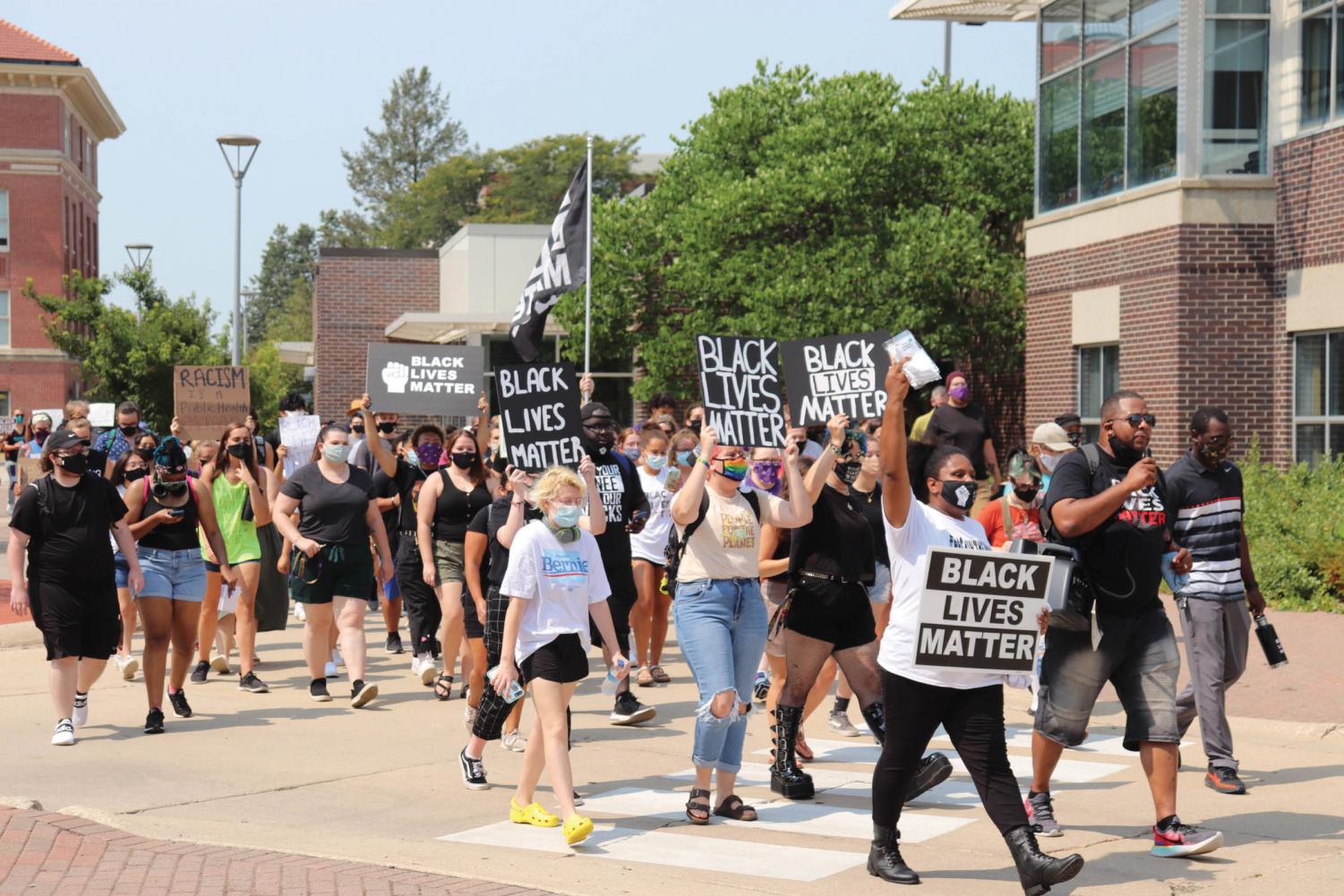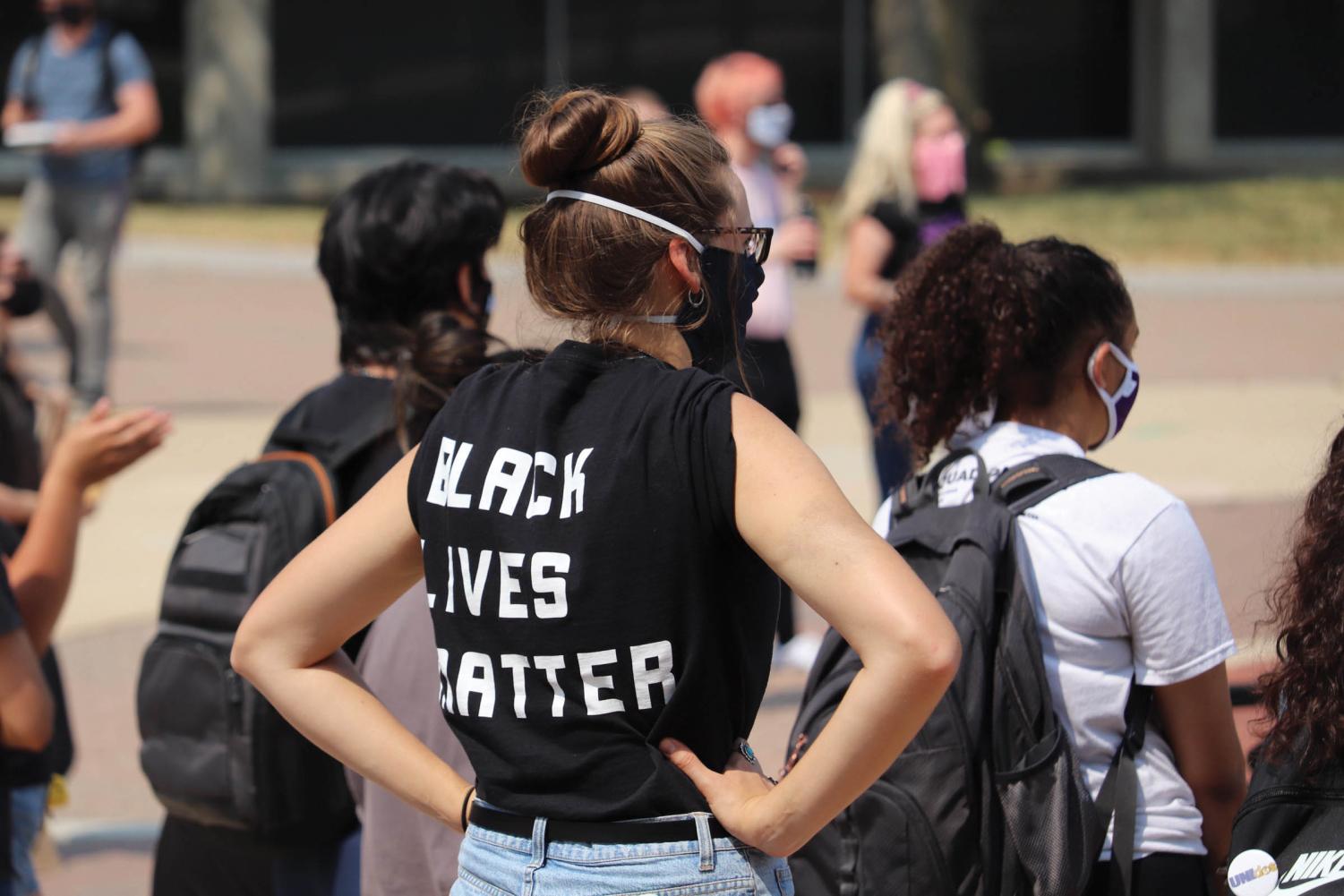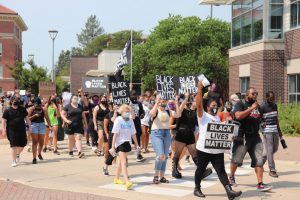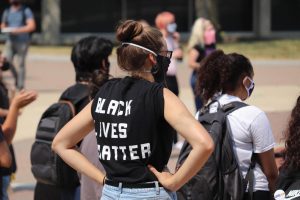BLM march draws crowd on campus
Aug 27, 2020
Despite the oppressive midday heat, over one hundred students and faculty members showed up Monday for the first Black Lives Matter march of the fall semester.
To passersby, those gathered around the Maucker Union fountain appeared a united front. All protesters came masked as per UNI’s policy and the organizer’s Facebook event page, and additional masks and coolers of cold water were also provided on site.
Participants arrived in various states — some with homemade signs at the ready, others dressed in black as a show of solidarity and many still carrying backpacks having just come from class. But all came with a common goal: to peacefully support a cause they believe in.
“The goal of the march is just to be present on UNI campus. To really start the semester off with letting them know that Black lives matter,” said UNI doctoral student Joyce Levingston, one of the organizers of the march. “We’re going to carry the momentum for Black lives really mattering in every space in our community, and that includes UNI’s campus.”
As one of the event’s main speakers, Levingston explained that in many recent cases at UNI, the voices of minority students have been suppressed when raised in alarm to the actions of their university. She maintained that the surrounding community and the students and faculty of UNI cannot allow comfort to settle over campus.
“We can’t let UNI be comfortable,” Levingston said. “We don’t want professors getting comfortable. We don’t want the president getting comfortable.”
As a long-time UNI student and activist, Levingston addressed issues specific to UNI that she’d personally faced. These included microaggressions in the classroom, which she described as instances of “racial abuse,” as well as tokenism in UNI’s use of racial diversity on campus in their advertisements
and media. “
What they do is use me as a Black token,” she said. “They can put me on the front screen of the UNI website, or they can write their story up and share it. And then they can recruit other Black students that way.”
However, she acknowledged that UNI still offers students opportunities for an education and a platform and that she has benefited from that platform while working to better the community.
“But I also have real life and real truth experiences here, “ she said, “that are cut away from the public on purpose.”
Other speakers included Nawal Rai, who discussed privilege, and Nilvia Reyes Rodriguez, who shared her experiences of similarity between the Black, immigrant and Indigenous communities in America.
“This fight for Black lives is not meant to be fought by Black lives alone,” Reyes Rodriguez said.
Though the march was not organized specifically in response to the shooting of Jacob Blake, a man who was shot in the back seven times by police in Kenosha, Wis. on Sunday night, several speakers reflected on the event. Among them was Ross Smith from UNI’s Executive Academic Committee.
“I’m reminded that since George Floyd, we haven’t stopped having George Floyds,” he said.
After the speakers concluded, Levingston and her fellow organizers, UNI professor David Hernandez-Saca and doctoral student Shehreen Iqtadar, led marchers to the president’s house. Due to the heat, prior plans for the march, which would have led participants through various areas of campus including Rod Library and Maucker Union, were cut shorter.
As they marched, protestors chanted “No justice, no peace! No racist police!” and called for immediate justice for Breonna Taylor and George Floyd.
Once they reached the president’s house, although President Mark Nook was not present, Hernandez-Saca read the protestors’ list of demands.
The list included diversification of syllabi by emphasizing texts written by authors of color, a presidential decree supporting university-wide social justice curriculum and the publication of Black, Indigenous and students of colors’ “real lives” in UNI media. In addition, he called for greater presidential collaboration with social justice groups on- and off-campus, as well as support for the establishment of a BLM chapter at UNI.
“These demands are from our collective consciousness,” Hernandez-Saca said.
When the march was disbanded, participants were left with an enjoyable and meaningful experience that helped to “elevate the stories of minorities on campus,” as one protester said.
For more information of future BLM protests, please contact Joyce Levingston at [email protected].










